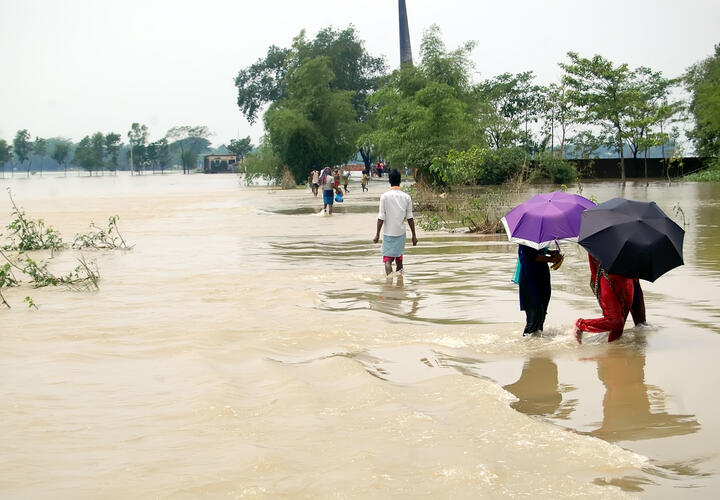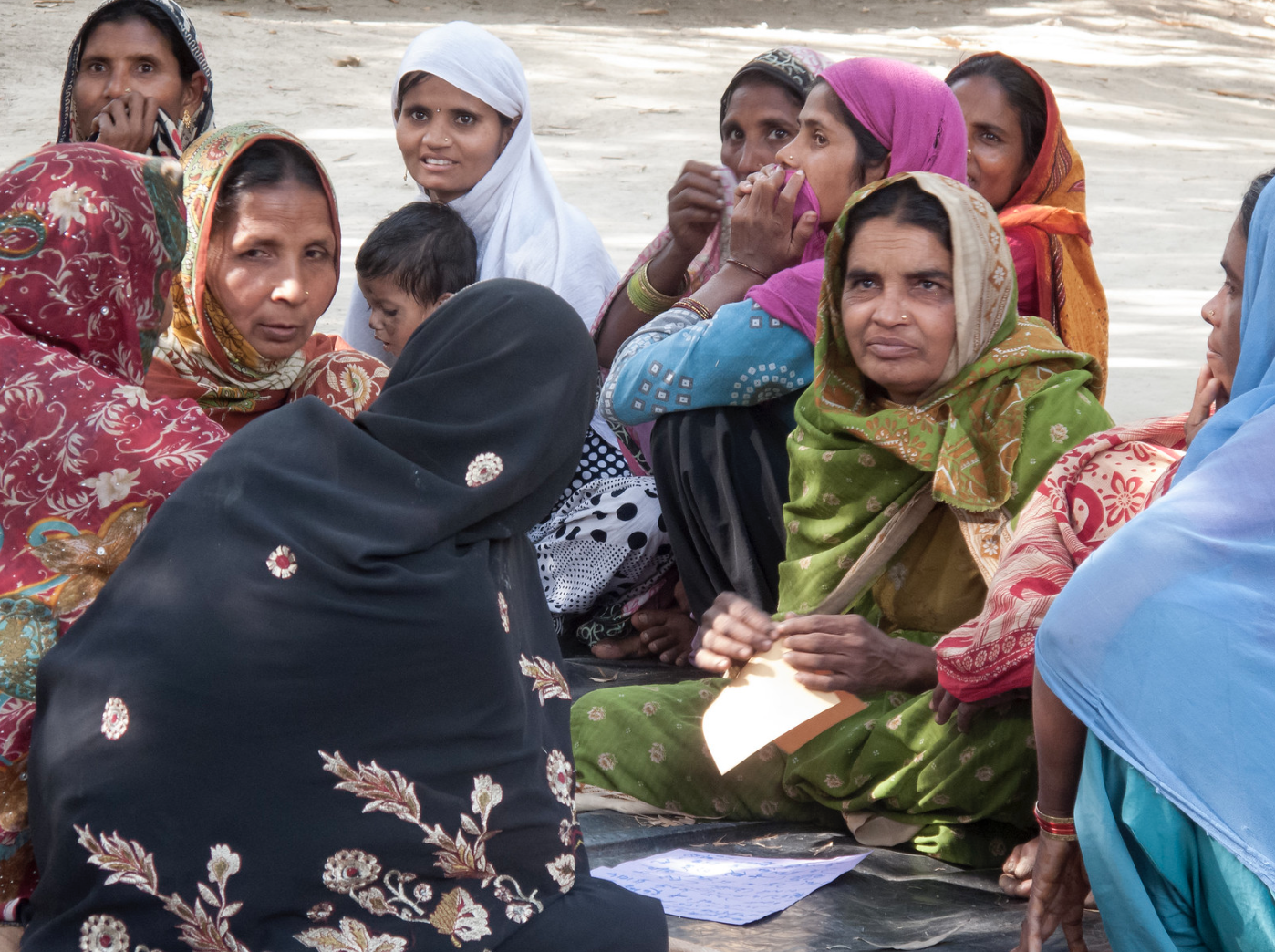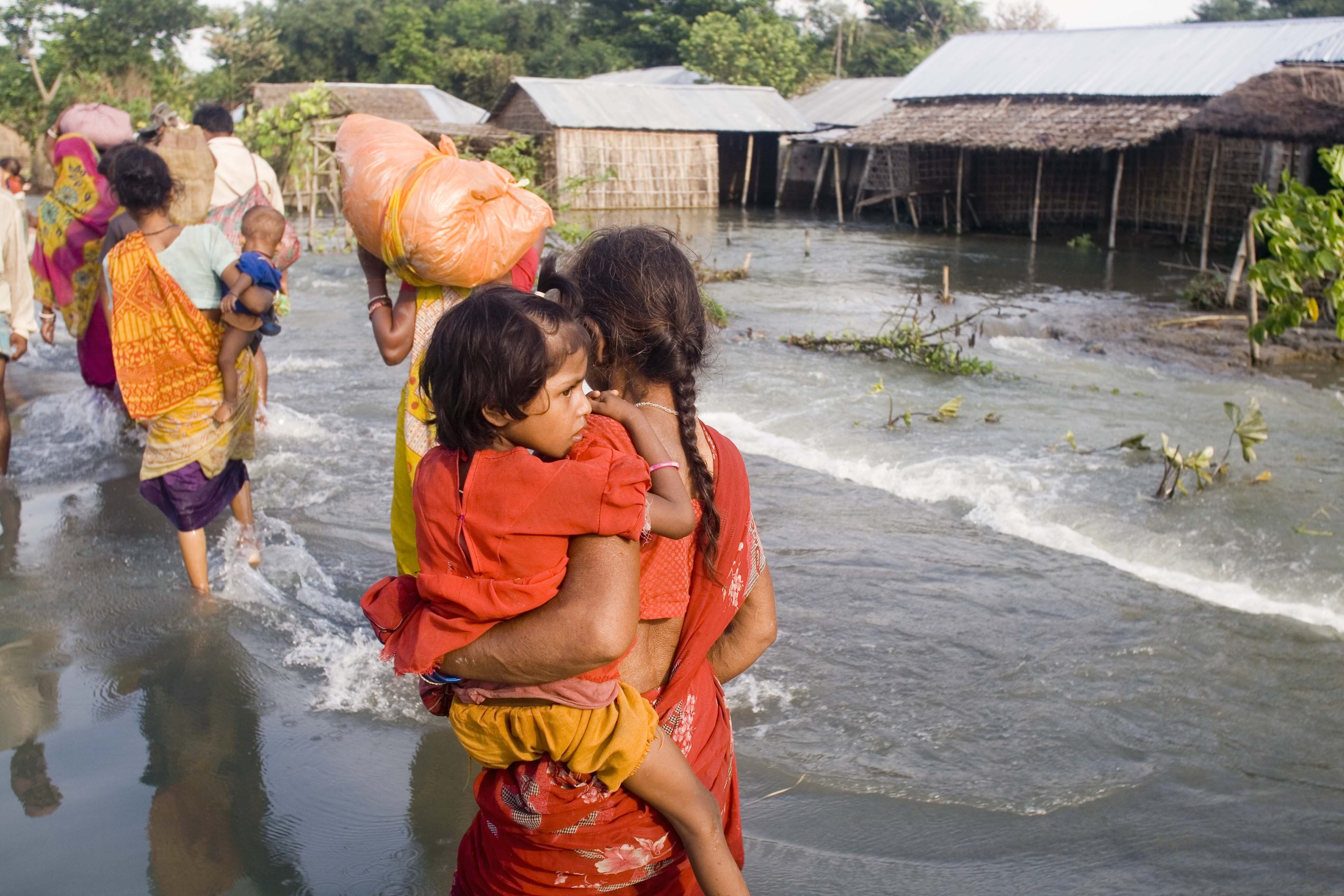Closing gaps at the nexus of gender and climate vulnerability
New technology can predict annual river floods with increasing accuracy, but the information is often inaccessible to women and other vulnerable groups. In this article, Inclusion Economics team members describe a research collaboration with Google.org and Yuganter - a Bihar-based NGO - that is recruiting women to reach women.

“During the flooding season, when the floods come, there is fear in everyone’s hearts,” Anjana Kumari said. “There are many kinds of difficulties we have to face.”
Kumari lives in the state of Bihar in eastern India where she is a member of the local women’s self-help group, JEEViKA. She told us that, although her village was flooded during the 2022 monsoon season, it wasn’t as bad as in previous years: “The water wasn’t very deep this time…It [only] reached above my waist.”
Her reflection speaks to how common and severe annual floods are for communities living in the Kosi and Ganges River basins. With over 97 million people exposed to inland flooding, India has the world’s largest flood-prone population. Seasonal floods can wreak havoc not only through immediate losses in income and livelihoods, but by driving transmission of water-borne diseases and disrupting rural residents’ mobility for months due to washed-out lanes. Even in the relatively mild flood season of 2022, Kumari said that the flood waters persisted for four months.
 Photo by the Climate Centre
Photo by the Climate Centre
Women in a community in Bihar prone to prone to floods being trained on creating local "disaster contingency plans" that can help take early action before the floods.
The stubborn cycle and prolonged nature of flooding in Bihari communities – combined with the increased incidence and variability of extreme weather events due to climate change – mean that women in low-income settings are even more disproportionately impacted at various stages of the flooding event and response cycle. Research based on a historical review of flood events from 1980 to 2009 indicates that in developing countries, flood-related mortality is higher among women than men. In another study examining the impact of natural disasters on child health in rural India, the authors find that the effects vary by the child’s gender, with girls more likely to experience negative long-term nutritional outcomes in the aftermath of disasters.
Advancements in predictive technology driven by artificial intelligence and machine learning – exemplified by Google’s state-of-the-art flood forecasting models – can provide a gateway to facilitate adequate disaster response and support community adaptation approaches and resilience strategies at the local level. FloodHub, a public tool launched by Google’s Flood Forecasting Initiative in 2018, generates advanced flood alerts that reliably predict flood location and localized water depth with a lead time of three to four days. These early flood warnings are further broadcast through Google Search, Google Maps, and via notifications on Android mobile phones with location services enabled.
However, the true potential of accurate and timely early warning systems in low-income settings is often undermined by poor accessibility and limited comprehension of these alerts among vulnerable populations. With support from Google’s philanthropic arm, Google.org, a team of researchers based at Inclusion Economics India Centre (based at IFMR/Krea University) and Inclusion Economics at Yale University is working to make these alerts accessible and actionable for at-risk communities and underserved groups, including women. The project uses an experimental design to test novel community-centered dissemination methods in villages like Kumari’s across 12 districts of Bihar.
The research team has collaborated with Yuganter – a Bihar based organization that works on disaster relief and preparedness – to recruit local volunteers from their networks with the goal of helping communities undertake timely preventive measures. These grassroots volunteers are trained to understand advanced alerts from Google’s FloodHub tool and amplify their reach and salience using community outreach activities that employ a hybrid of digital and traditional communication channels.
The researchers have taken a gender-intentional lens in the design of the intervention to further facilitate a user-friendly dissemination approach. “Women and men also have different responsibilities during floods, and abilities in how they respond,” noted Rohini Pande, Henry J. Heinz II Professor of Economics and Director of the Economic Growth Center at Yale University, one of the Principal Investigators on the study. Focus group discussions with community members indicated that while men tend to take the livestock and leave the region in boats, women tend to stay back with the children and move to the roofs of the house or to the highways. "There are also huge gender gaps in smartphone usage and access in this area, like most other areas in India,” Pande added.
To address gender-specific barriers in accessing information, the team worked to recruit and include women volunteers – a prospect that also entailed grappling with challenges related to norms around women’s mobility and participation – with the aim of reaching groups who might otherwise be left out.
This was one component of a wider effort. During the 2022 monsoon season (June-October), when over 27,000 flood alerts were sent to volunteers operating in 160 panchayats in Bihar, local volunteers acted on 81% of these alerts to help disseminate the warnings widely in their local communities. An accompanying midline survey conducted by the researchers indicated that households in treatment communities had better access to alerts, in terms of receipt, timeliness, and perceptions of accuracy.
 Photo by bodum.
Photo by bodum.
A child being carried as flood victims move to safer places in the Purniya district Bihar India, in the aftermath of the 2008 Bihar floods.
To further build trust in these alerts, the researchers plan to test the effects of leveraging and including local leaders in the alert outreach model during the 2023 flood season. Results from the 2019 pilot which involved sending flood alerts to local leaders suggest that women local leaders had higher recall of receiving and disseminating them to villagers. “It seemed like the women leaders paid more attention to floods than men leaders,” said Maulik Jagnani, Assistant Professor of Economics at the University of Colorado, one of the other Principal Investigators of the study. Exploring the gender-specific impacts of such components in the alert delivery model can help identify ways to make these systems truly integrated and inclusive.
Anjana Kumari herself joined the effort during the 2022 monsoon season – while she was pregnant – to alert people in her community to imminent floods.
Her experience in the program suggests that building trust among community members requires time. She had the support of her husband, family, and other women in the community, yet her participation in the project wasn’t without some resistance. “The villagers used to taunt me and my family initially,” she said. “It took some time for them to trust and pay heed to what I was saying in the village.” Ultimately, though, Kumari feels that it has been gratifying for her to be of service to her community.
The assessment of researchers backs Kumari up. “We really needed women to reach women,” Pande said.
The authors wish to thank Sathia Chakrapani, Advait Moharir, Surya Ravindran, Rajesh Sarma, and project Field-Managers for conducting interviews in Bihar